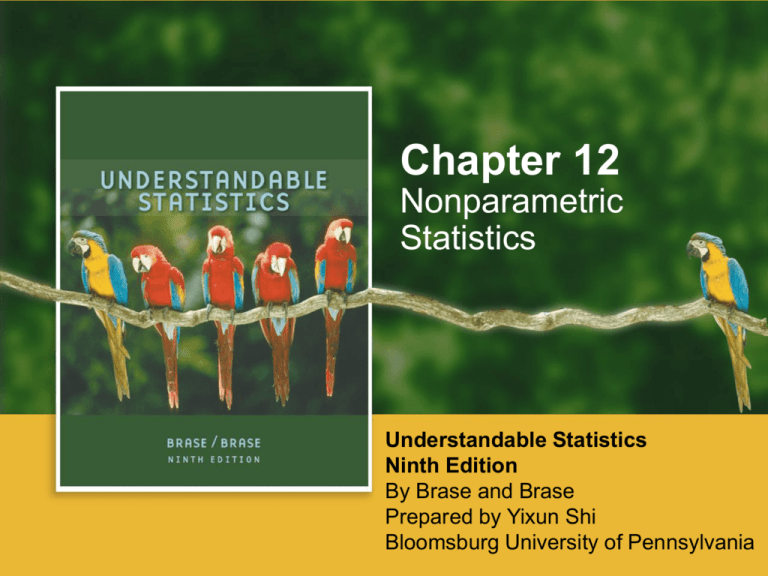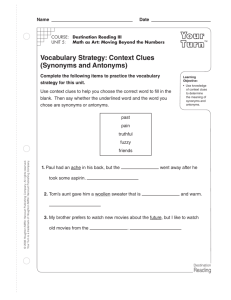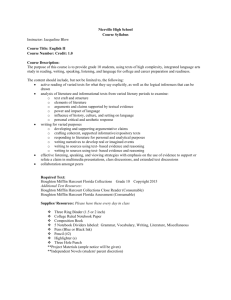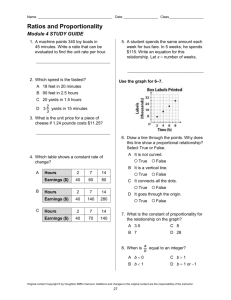
Chapter 12
Nonparametric
Statistics
Understandable Statistics
Ninth Edition
By Brase and Brase
Prepared by Yixun Shi
Bloomsburg University of Pennsylvania
Nonparametric Situations
• At times, we will not know anything about the
distributions of the populations from which we
are sampling.
• Recall that all of our inference techniques thus
far have assumed either a normal or binomial
distribution from the populations of interest.
Copyright © Houghton Mifflin Harcourt Publishing Company. All rights reserved.
12 | 2
Nonparametric Tests
• Advantages:
– Easy to apply
– Quite general in nature
• Disadvantages:
– Wastes information
– Accept the null hypothesis more often than
with other tests
– Less sensitive
Copyright © Houghton Mifflin Harcourt Publishing Company. All rights reserved.
12 | 3
The Sign Test
• We wish to compare two populations.
– Populations are not independent
Copyright © Houghton Mifflin Harcourt Publishing Company. All rights reserved.
12 | 4
Sign Test Method
Copyright © Houghton Mifflin Harcourt Publishing Company. All rights reserved.
12 | 5
Sign Test Method
Copyright © Houghton Mifflin Harcourt Publishing Company. All rights reserved.
12 | 6
Sign Test Method
Copyright © Houghton Mifflin Harcourt Publishing Company. All rights reserved.
12 | 7
Rank-Sum Test
• Data values from the two populations are not
paired.
• Normal assumptions are not satisfied, or are at
least questionable.
Copyright © Houghton Mifflin Harcourt Publishing Company. All rights reserved.
12 | 8
Rank-Sum Test
Copyright © Houghton Mifflin Harcourt Publishing Company. All rights reserved.
12 | 9
Rank-Sum Test
Copyright © Houghton Mifflin Harcourt Publishing Company. All rights reserved.
12 | 10
Rank-Sum Test
Copyright © Houghton Mifflin Harcourt Publishing Company. All rights reserved.
12 | 11
Rank-Sum Test
Copyright © Houghton Mifflin Harcourt Publishing Company. All rights reserved.
12 | 12
Spearman Rank Correlation
• Suppose we have a sample of size n of paired
data points (x, y).
• The data points, (x, y), must be ranked
variables.
• The Spearman Rank Correlation will tell us if
the data pairs have a monotone increasing or a
monotone decreasing relationship.
Copyright © Houghton Mifflin Harcourt Publishing Company. All rights reserved.
12 | 13
Spearman Rank Correlation Coefficient
Copyright © Houghton Mifflin Harcourt Publishing Company. All rights reserved.
12 | 14
Spearman Rank Correlation Properties
Copyright © Houghton Mifflin Harcourt Publishing Company. All rights reserved.
12 | 15
Spearman Rank Correlation Properties
Copyright © Houghton Mifflin Harcourt Publishing Company. All rights reserved.
12 | 16
Test for Spearman Correlation
Copyright © Houghton Mifflin Harcourt Publishing Company. All rights reserved.
12 | 17
Test for Spearman Correlation
Copyright © Houghton Mifflin Harcourt Publishing Company. All rights reserved.
12 | 18
Spearman Correlation Test
Copyright © Houghton Mifflin Harcourt Publishing Company. All rights reserved.
12 | 19
Spearman Correlation Test
Copyright © Houghton Mifflin Harcourt Publishing Company. All rights reserved.
12 | 20
Spearman Correlation Test
Copyright © Houghton Mifflin Harcourt Publishing Company. All rights reserved.
12 | 21
Runs Test for Randomness
• Definitions:
Copyright © Houghton Mifflin Harcourt Publishing Company. All rights reserved.
12 | 22
Runs Test for Randomness Hypotheses
Copyright © Houghton Mifflin Harcourt Publishing Company. All rights reserved.
12 | 23
Conducting the Test
Copyright © Houghton Mifflin Harcourt Publishing Company. All rights reserved.
12 | 24
Constructing a Runs Test
Copyright © Houghton Mifflin Harcourt Publishing Company. All rights reserved.
12 | 25
Constructing a Runs Test
Copyright © Houghton Mifflin Harcourt Publishing Company. All rights reserved.
12 | 26
Constructing a Runs Test
Copyright © Houghton Mifflin Harcourt Publishing Company. All rights reserved.
12 | 27
Constructing a Runs Test
Copyright © Houghton Mifflin Harcourt Publishing Company. All rights reserved.
12 | 28





